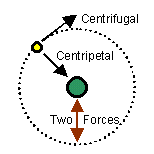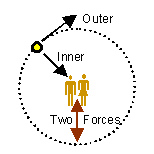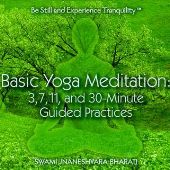|
|
|
|||||||||
| Two Forces in Physics | Two Directions for People |
 |
 |
|
There are two forces at play with a satellite in orbit or a rock swung in a circle on the end of a string. One force would have the satellite or rock continue its journey away from the center; this is the centrifugal force. The other force pulls the object inward through gravity or the strength of the string; this is the centripetal force. To have the two forces in balance is what allows the satellite to stay in its orbit and the rock in its circuitous arc. |
There are also two forces at play with human beings. One force is that of consciousness ever moving outward, manifesting through intellect, ego, mind, senses, and actions. The other force is that inner draw or pull for all of these to recede, so that the consciousness might rest in its own true nature, which is called Self-Realization. To have the highest inner Realization while engaging in the world is the highest goal. |
Receding rather than Traveling
In spiritual life and the path of enlightenment, it is not that there is a discrete "I" as a collection of mental and emotional traits who travels from here to there, from this realm to that realm, and on to the next realm. Rather, our consciousness, soul, spirit, or whatever else you want to call it manifests outward through individuation, intellect, ego, mind, and sensory-motor instruments so that we may engage the external world. Then, on the return journey, all of these recede back into one another. The sensory-motor instruments, mind, ego and intellect all recede back into that from which they originally emerged.
In this way latent impressions manifest as dreams or unconscious mental process, and then spring forth into actions in the world. After the actions or the dreams have played out, those images all recede back into the latent bed of the unconscious mind from which they had emerged. So too, when we turn inward from the actions of the world, withdraw the senses, allow the mind to recede into rest, it is a process of receding rather than a process of a discrete "I" taking a journey.
In both the processes of being and acting in the world and the processes of dreaming, there are two underlying processes. One is the expansion or manifesting outward, and the other is that of receding. Ornaments manifest out of gold, though the gold does not travel anywhere. Pots manifests out of clay, though the clay does not travel anywhere. Ornaments may recede back into being only a piece of gold, though the gold did not travel anywhere. Pots may recede back into being only a lump of clay, though the clay did not travel anywhere. So too, we manifest outward through individuation, intellect, ego, mind, and sensory-motor instruments, though the deepest being who we are does not travel anywhere. So too, the sensory-motor instruments, mind, ego, intellect, and individuation recede back into our true essence, though that essence did not travel anywhere.
Outward and inward, manifesting and receding; those are the two directions, like the centrifugal and centripetal forces, while never is there any traveling of the innermost essence.
Two Forces in Yoga, Vedanta and Tantra
These two forces (centripetal and centrifugal) are contained in virtually all of the conceptual systems of meditation and contemplation, including the three streams of Yoga, Vedanta and Tantra (see the article on the Three Streams).
Sankhya-Yoga: In Sankhya, which is the foundation for Yoga, there is Purusha, consciousness, along with the many manifestations of Prakriti, the subltest "matter." (See Sankhya)
Vedanta: In Vedanta, there is the Atman, the individual Self and Brahman, the absolute reality, along with the appearances of sheaths manifesting out of Maya, the illusion or unreality. (See Sheaths)
Tantra: In Tantra, there is Shiva, the latent, formless masculine essence, along with Shakti, the beautiful, creative feminine force that plays its way into manifestation. (See Shiva-Shakti)
While each of these three have their own perspective, the seeker of Self-Realization will see how they work together, or play together, and that in all of them, there are two forces in action; one is outer, centripetal, and the other is inner, centrifugal. This is one of the ways in which the three streams of Yoga, Vedanta and Tantra are companions on the journey to Self-Realization.
|
A satellite in a geostationary orbit (remaining over one location on the Earth) is held in place because of the perfect balance between gravity (centripetal force) and its inertia (centrifugal force). Imagine that the satellite stopped its forward motion of about 17,000 miles per hour. The satellite would immediately start falling toward Earth at a very fast speed. Imagine for a moment a human stopping his or her outward momentum into the external world, as well as ceasing motion of awareness "outward" into the stuff of the mind and body. Instantly, she or he would move "inward" towards the center of consciousness, the true Self, or whatever you wish to call that. This is one way of viewing the Yoga process of surrender. It is not a matter of defining to whom or what you surrender, but the letting go process itself. Thus, Yoga Sutras 1.2-1.3 describes Yoga as a process of setting aside or letting go, etc. (nirodhah), which results in the seer or witness resting in its own true nature. This is one way of explaining the meaning of the phrase Self-Realization and the word Yoga. |
Don't remove the Inner, Centripetal force
There is somewhat subtle point about rocks on a string and the journey of humans. Once this point is understood, it is extremely practical in daily life and the seeking of Self-Realization.
First, the physics part. If you are swinging a rock on a string and the string breaks, the rock flies away. Most of us would say that this flying away is caused by the centrifugal force, the outward pull. However, the Newtonian physicists explain that it is not the outward pull that does this, but instead, it is the cessation or removal of the centripetal force, the release of the inner pull that allows the rock to fly outward. They explain this in the context of Newton's laws of motion. If you are curious about the details of this process, internet searches of centripetal and centrifugal forces will lead you to further explanations.
Second, the life part. It seems that the vast majority of people turn to meditation and contemplation, the journey of Self-Realization, out of a sense of having lived in the external world and finding it lacking something. Often, people run into painful experiences, which drive them to seek within, turning away from the world. It can seem that it is the world and the other people who are causing the suffering, just as it can seem that it is the centrifugal force that causes the rock to fly away. That's not really a complete explanation of what leads to the suffering. What is more true is that the cessation or removal of our connection to the inner source, who we really are, is the bigger problem, as in the case of the string and the rock.
|
As with the
rock and the string, |
Often, people get the impression that living a life of meditation and contemplation means not enjoying life in the external world, as if everybody is supposed to give up all their belongings and relationships and go live in a cave. It can seem as if texts and teachers are all saying this, that they should not have fun in life, that they should become boring people. However, it is not the world and its attractions that is the problem. Rather, as with the rock and the string, the cause of the suffering is forgetting to maintain a constant awareness of the center of consciousness, cutting ourselves off from the Atman, the Self. When that awareness is cut off, like the removal cessation or removal of the centripetal force with the rock and the string, we can easily suffer as we naturally fly off into the allurements of worldly life.
The solution is simple; maintain a constant awareness of seeking the highest Reality, the highest Truth, the direct experience of the Absolute, the center of consciousness, the Self or Atman. Here, we are not talking about whether you have or have not yet actually realized that Self. Rather, we are talking about the fact that the gently constant awareness of seeking it acts like the string in relation to the rock. That constant awareness keeps life in the external world in balance. It brings equanimity, peace of mind, or contentment, which is called santosha in Sanskrit. This santosha is part of rung two, the niyamas, of the eight rungs of Yoga, as described in the Yoga Sutras (Yoga Sutras 2.26-2.29, 2.30-2.34, 2.35-2.45). To keep a sense of contentment, don't remove the string, the connection with the innermost center of consciousness. Keep a gentle, yet steady awareness of that innermost source. That awareness is the centripetal force that keeps the centrifugal force of worldly life in balance.
-------
This site is devoted to presenting the ancient Self-Realization path of the Tradition of the Himalayan masters in simple, understandable and beneficial ways, while not compromising quality or depth. The goal of our sadhana or practices is the highest Joy that comes from the Realization in direct experience of the center of consciousness, the Self, the Atman or Purusha, which is one and the same with the Absolute Reality. This Self-Realization comes through Yoga meditation of the Yoga Sutras, the contemplative insight of Advaita Vedanta, and the intense devotion of Samaya Sri Vidya Tantra, the three of which complement one another like fingers on a hand. We employ the classical approaches of Raja, Jnana, Karma, and Bhakti Yoga, as well as Hatha, Kriya, Kundalini, Laya, Mantra, Nada, Siddha, and Tantra Yoga. Meditation, contemplation, mantra and prayer finally converge into a unified force directed towards the final stage, piercing the pearl of wisdom called bindu, leading to the Absolute.

